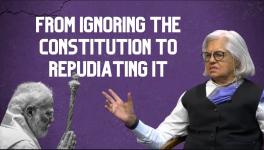Probing Corporal Safety of Women in Live-in Relationships

Representational Image.
The jurisprudence surrounding live-in relationships is replete with a common underlying theme that two consenting adults are at the liberty to live together, and no person would be permitted to interfere in their peaceful cohabitation.
—–
The activism of the Indian judiciary in terms of formal recognition of live-in relationships has opened a vista of allied freedoms for live-in partners. However, the reality of women in such relations remains grim.
The right to love stems from the hackneyed fundamental rights to life and freedom of expression guaranteed under Articles 21 and 19(1)(a) of the Constitution, respectively. The lack of a formal legislation on the subject is seen as a bane instead of a boon as unsaid social rules in India dominate the minds of generations across. The struggles of two individuals, located within the larger history of biases against various forms of social subordination, often on lines of inter-community or inter-religious relationships, are actively sought to be curbed by the society in general.
However, objectively speaking, in intimate partnerships, the desperate pursuance of exercising the right to love also apprehends an enormous two-pronged personal risk, in the form of ruffling an antiquated line of social authority and the corporal safety of women in such relationships. High standards of social morality often overburden the institution of marriage, and demonising live-in relationships is a succinct example of the conflict between social security and individual liberty. It reveals the need for evolution of social norms in terms of accommodating the contemporary necessity of the egalitarian partners whilst also ensuring personal safety.
In intimate partnerships, the desperate pursuance of exercising the right to love also apprehends an enormous two-pronged personal risk, in the form of ruffling an antiquated line of social authority and the corporal safety of women in such relationships.
November last year witnessed a national outrage over the macabre murder of Shraddha Walkar, her sawed body being spread over different parts of the Indian capital by live-in partner Aftab Poonawala. While global trends are tipping towards strengthening sexual privacy, the sanctity and security of women in such relationships stands threatened.
Legislative provisions and judicial pronouncements on live-in relationships in India
The judiciary has rather assiduously addressed allied issues on live-in relationships by expanding the scope of Section 125 (order for maintenance of wives, children and parents) of the Criminal Procedure Code, 1973, and Section 2(f) (definition of ‘domestic relationship’) of the Protection of Women from Domestic Violence Act, 2005 (DV Act). The said sections were expanded to entitle aggrieved women to maintenance and to legal protection against sexual atrocities within live-in relationships.
In Indra Sarma versus V.K.V. Sarma (2013), the Supreme Court held that “live-in or marriage-like relationship is neither a crime nor a sin though socially unacceptable in this country. The decision to marry or not to marry or to have a heterosexual relationship is intensely personal.” The court outlined the following eight guidelines to determine a live-in relationship, with the caveat that the said guidelines were not exhaustive:
“1) Duration of period of relationship: Section 2(f) of the DV Act has used the expression ‘at any point of time’, which means a reasonable period of time to maintain and continue a relationship which may vary from case to case, depending upon the fact situation.
(2) Shared household: The expression has been defined under Section 2(s) of the DV Act and, hence, need no further elaboration.
(3) Pooling of resources and financial arrangements: Supporting each other, or any one of them, financially, sharing bank accounts, acquiring immovable properties in joint names or in the name of the woman, long-term investments in business, shares in separate and joint names, so as to have a long standing relationship, may be a guiding factor.
(4) Domestic arrangements: Entrusting the responsibility, especially on the woman to run the home, do the household activities like cleaning, cooking, maintaining or upkeeping the house, etc. is an indication of a relationship in the nature of marriage.
(5) Sexual relationship: Marriage like relationship refers to sexual relationship, not just for pleasure, but for emotional and intimate relationship, for procreation of children, so as to give emotional support, companionship and also material affection, caring etc.
(6) Children: Having children is a strong indication of a relationship in the nature of marriage. Parties, therefore, intend to have a long-standing relationship. Sharing the responsibility for bringing up and supporting them is also a strong indication.
(7) Socialisation in public: Holding out to the public and socialising with friends, relations and others, as if they are husband and wife is a strong circumstance to hold the relationship is in the nature of marriage.
(8) Intention and conduct of the parties: Common intention of parties as to what their relationship is to be and to involve, and as to their respective roles and responsibilities, primarily determines the nature of that relationship.”
In D. Velusamy versus D. Patchaiammal (2010), the Supreme Court observed:
“In our opinion a ‘relationship in the nature of marriage’ is akin to a common law marriage. Common law marriages require that although not being formally married:
(a) The couple must hold themselves out to society as being akin to spouses.
(b) They must be of legal age to marry.
(c) They must be otherwise qualified to enter into a legal marriage, including being unmarried.
(d) They must have voluntarily cohabited and held themselves out to the world as being akin to spouses for a significant period of time.”
Constitutional courts have at length discussed that live-in relationships, despite not being socially accepted in India, do not contemplate any offence under law. The jurisprudence surrounding live-in relationships is replete with a common underlying theme that two consenting adults are at the liberty to live together, and no person would be permitted to interfere in their peaceful cohabitation. In Lata Singh versus State of U.P. (2006), it was again pointed out by the Supreme Court that a major woman has the right to marry or to live with anyone of her own free will.
The DV Act includes the concept of live-in-relationship and action can be kick-started under the Act by a woman against the man she is cohabiting with, but it has not been of much avail to women due to lack of knowledge about their rights under the Act and an overburdened pile of matrimonial litigation.
However, given the plurality of traditional Indian society, where moralistic codes are embedded in religious sentiments, the notion of marriage is still exalted as the purest institution of building a stable domestic relationship and expanding progeny. Marriage is perceived to provide socio-economic and legal security to those involved, specially the wives and children.
However, in live-in relationships, women retain their independent identity and in strict sensu are not recognised as wives since they can separate informally without observing a legal procedure for divorce. It is from such ambiguity that seem to stem issues of guardianship, maintenance and even the very legitimacy of children born out of such partnerships.
Fortunately, in situations wherein children are borne to such partnerships, the legitimacy of such children too has been recognised legally and judicially. For instance, the Supreme Court in Revanasiddappa versus Mallikarjun (2011) declared children as ‘legal heirs’ of a man in a live-in partnership with their mother, and granted inheritance rights to such children.
Additionally, even in the sphere of intimacy, there are instances wherein female partners have levelled allegations of rape on the pretext of false promise of marriage in situations wherein disputes surfaced in such live-in relationships. Legally speaking, marriage is presumed to provide unlimited sexual access to the respective partners as a matter of legal right (even though the legality of such unperturbed access is a matter which is still subjudice before the Supreme Court). Nevertheless, making a false promise of marriage is different than branding consensual sexual intercourse of any kind as rape.
Yet, the problem sustains in situations wherein sexual access of a male partner to the female counterpart and the notion of consent in such live-in relationships raises concerns owing to an eclipsed notion of consent. Furthermore, family progression also gets hampered due to the lack of faith and commitment between cohabiting partners, especially in terms of asserting rights of maintenance and inheritance, among other concerns.
Though the judiciary has elucidated a few in-exhaustive situations wherein a domestic relationship is defined as a live-in relationship, the definitional scope of husband or wife yet remains restricted to legally married partners. The report of the Justice V.S. Malimath-led Committee on Reforms of Criminal Justice System in 2003 did attempt at suggesting an expansion in the definitional scope of “wife” under Section 125 of the Criminal Procedure Code, but it was never implemented.
A crucial development that has taken place is that the DV Act includes the concept of live-in-relationship and action can be kick-started under the Act by a woman against the man she is cohabiting with, but it has not been of much avail to women due to lack of knowledge about their rights under the Act and an overburdened pile of matrimonial litigation.
The way forward?
In its landmark judgment in Navtej Singh Johar versus Union of India (2018), the Supreme Court noted:
“Consensual sexual relationships between adults based on the human propensity to experience desire must be treated with respect. In addition to respect for relationships based on consent, it is important to foster a society where individuals find the ability for unhindered expression of the love they experience towards their partner.”
The sentiments of our progressive judiciary requires legislative synergies to align. Social dynamism warrants both moralistic and legislative ministrations, without which social handicaps manifest into gruesome crimes. The dire need to develop an in-depth understanding of the subtleties of both marriage and cohabitation requires the interests of the parties to be protected by the State. In the absence of legal clarity, social norms still seem to dictate judicial exemplars.
Mahalakshmi Pavani is a Senior Advocate in the Supreme Court of India.
Get the latest reports & analysis with people's perspective on Protests, movements & deep analytical videos, discussions of the current affairs in your Telegram app. Subscribe to NewsClick's Telegram channel & get Real-Time updates on stories, as they get published on our website.























